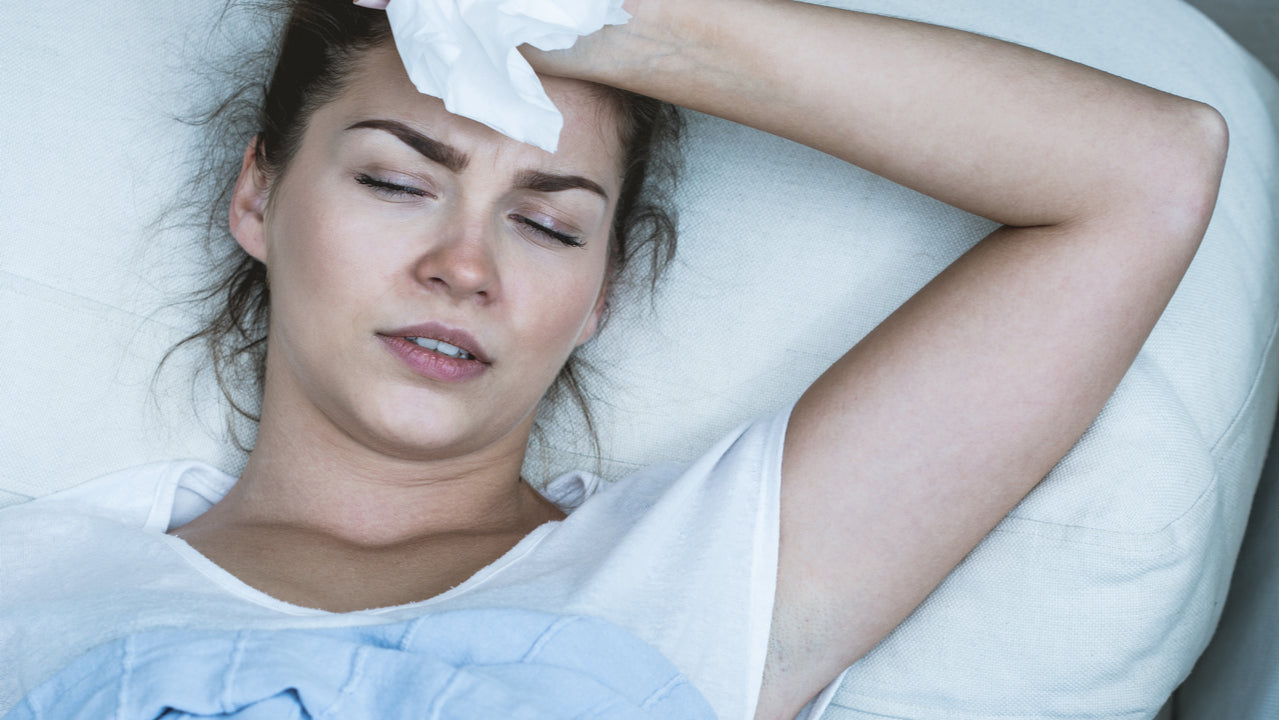If you’ve ever had a runny nose, itchy eyes, and you can’t stop sneezing, you might have allergic rhinitis (AR), also known as hay fever. AR affects roughly 60 million people in the United States, and the rate is growing. About 40 percent of people who experience AR are children.
People think hay fever is only present during certain months, but there are two types of hay fever—seasonal and perennial. People who experience seasonal allergies are most likely to have symptoms during the spring, summer or early fall. Perennial hay fever sufferers experience symptoms year round.
One study determined that 68 percent of people with perennial AR and 48 percent of people with seasonal AR said allergy symptoms like sneezing and itchiness made it difficult to sleep.
Allergy symptoms can happen at any time, but they tend to be more frequent at night. Next, we’ll discuss why.
Why Do My Allergies Get Worse at Night?
There are a few reasons why allergies affect sleep. For one, cortisol levels drop at night, which affects cells that manage inflammation; meaning allergic symptoms, like obstructed airways and nasal congestion, can be more prominent at night. Histamine, a chemical released when allergic reactions occur, can also disturb sleep because of its role in the sleep-wake cycle.
Hay fever has also been shown to contribute to anxiety, which can lead to further sleep deprivation. What’s more, many people also experience anxiety specifically about their inability to sleep. Because allergies, sleep, and anxiety are connected, people who suffer from hay fever might find themselves in an insufferable cycle when their symptoms are present.
Allergies, anxiety, and insomnia: a vicious cycle
Anyone who suffers from AR knows just how miserable it can be. Science has shown that the trifecta of allergies, anxiety, and insomnia can impact your quality of life, especially around bedtime. Here’s how the cycle works in five steps:
1. Step one
Allergies can make sleeping extremely difficult. When you’re dealing with a runny nose, itchy eyes, and a scratchy throat, the last thing you can focus on is falling asleep. In a study of 591 people with AR, respondents said that the biggest issue related to their condition was poor sleep quality and its consequences, like daytime drowsiness and trouble concentrating.
2. Step two
If you fall asleep, the sleep problems aren’t over. AR can cause a myriad of sleep quality issues. Multiple research studies have found that nasal obstruction due to AR can cause abnormal breathing, sleep apnea and snoring. One study, in particular, concluded that snoring and sleep apnea was much more common in people with AR, compared to a control group of people without AR.
3. Step three
Because people who have hay fever struggle to get a good night’s sleep, they often wake up feeling miserable and exhausted the next morning. That can lead to daytime sleepiness, difficulty concentrating, irritability and decreased cognitive function. Operating on too little sleep has a number of consequences — especially over the long-term. The risk of developing serious illnesses like hypertension, heart disease, obesity, diabetes, and some forms of cancer, increases with lack of sleep or poor sleep quality.
4. Step four
It can quickly start affecting your mental health when you struggle to fall asleep every night, and deal with extreme exhaustion during the day. In fact, seasonal allergies have been positively linked to both generalized anxiety disorder and depression. Depression is also correlated with perennial allergies, although year-round allergy sufferers rarely develop anxiety due to their symptoms. Perhaps because they have grown used to constant sneezing and runny noses.
In people who have allergies, depression and anxiety are shown to spend more money on medical and mental health treatment. According to one study, “Outpatient health care expenditures were increased by an average annual amount of $207 when AR and anxiety disorder were comorbid and $363 when AR and depression were comorbid.” The same study determined that people who took prescription medication for allergies spent less money on their depression and anxiety treatment.
5. Step five
The last step is when the cycle comes full circle—anxiety can make it difficult to fall asleep, and lying awake in bed at night can further exacerbate anxiety. Not to mention, you’re still dealing with debilitating allergy symptoms while this is happening.
Healthline states, “One of the most common times when people experience anxiety is at night. Many clinical trials have found that sleep deprivation can be a trigger for anxiety. Historically, research also suggests anxiety disorders are associated with reduced sleep.” One compelling study published in Psychology and Health also found that anxiety and depression showed moderate to strong ties to insomnia. Even if you don’t experience full-on insomnia, allergies can still make you tired during the day.
Reducing allergens in the bedroom
By removing allergies from the picture, sleep quality is improved, and the risk of anxiety and other mental health disorders is lower.
Eliminating allergens in your bedroom is the best way to reduce the chance that your allergy symptoms will act up at night and interfere with your sleep, making you tired during the day. However, this is often easier said than done. Allergy-causing substances are often found in common places, like your mattress and linens. Humans can easily bring outdoor allergens inside when they collect on clothing and hair.
Taking precautionary measures can help eliminate allergens in your home. Below, you can find ways to limit allergens from some of the most common sources in your bedroom.
Your mattress
Allergy-causing particles including dust mites and pet dander can collect on the soft fibers of your mattress, and contribute to less restful sleep. If your mattress doesn’t have a washable cover, it can be nearly impossible to remove allergens thoroughly from the surface.
To reduce the risk of allergens, look for a mattress that has a removable and machine washable cover that is easy to zip off for laundry day. Another option is to purchase a mattress made from 100% natural latex, which is naturally a hypoallergenic and antimicrobial material. Alternatively, if you’re not in the market for a new mattress, consider purchasing a washable mattress protector for an effective and budget-friendly solution.
Check out our list of the best mattresses for allergies and asthma to find one that fits your needs and budget.
Your sheets
Your linens and sheets can be a major culprit behind hidden bedroom allergens. Unlike a mattress, new sheets aren’t a huge investment, so it might be worth spending some money on ones that will help you sleep more soundly during allergy season.
If you’re suffering from hay fever, look for hypoallergenic bedding for protection against allergens. However, not all hypoallergenic sheets are created equal. There are four ways that hypoallergenic sheets prevent allergies:
- Fabric allergens: Natural and eco-friendly bedding is often made without materials or chemicals that people can be allergic to, such as wool or bamboo.
- Dust allergens: Some hypoallergenic sheets are made with a tight weave that doesn’t allow dust mites to penetrate the fabric.
- Mold allergens: People who are allergic to mold or mildew may benefit from mold-resistant bedding made from silk or bamboo.
- Allergen-repelling fabric: Some bedding is designed to repel allergens using synthetic material that blocks absorption.
If you’re looking to go all-in with your hypoallergenic bedding (which we recommend), you can also purchase pillowcases, duvet covers and blankets made with allergen-repelling fabric.
Though, it’s worth mentioning that even with hypoallergenic bedding, it’s still important to wash your sheets, pillows and blankets regularly in hot water. Washing your linens in water that is at least 140 degrees Fahrenheit has been shown to kill 100 percent of dust mites, about 90 percent of dog dander and roughly 97 percent of pollen.
Your pets
The last common source of bedroom allergens are pets. If your pets are spending time outside every day, especially when the pollen count is high, allergens can adhere to their fur and get brought inside. If your pets are allowed in your bed, that pollen is finding its way into your bed linens.
It’s unrealistic to rinse your pet’s fur every time they come in from outside. If you can’t keep your pet out of your bedroom, make sure you have hypoallergenic bedding and a mattress protector for easy washing.
If you experience year-round hay fever symptoms and you have a dog or cat in the house, it’s possible that you have a pet dander allergy. Pet dander allergies are fairly common, affecting as many as three out of every 10 people in the U.S. Evidence suggests that cat allergies are twice as common as dog allergies.
If you suspect that you’re allergic to your pet, it doesn’t mean you have to get rid of it. But it is especially important to keep the pet out of your bedroom, regularly clean surfaces, steam carpets, and wash your pet regularly.
Tips for better sleep during allergy season
Sleeping during allergy season can be challenging, but there are ways to make yourself more comfortable. Here are some of our favorite tips:
- Vacuum your bedroom daily, or every few days to remove pollen, dust and pet dander that might be lingering on the floors, especially carpet.
- Invest in a dehumidifier for your bedroom and run it daily to prevent mold growth and keep your HVAC system filters clean.
- Change into fresh clothes after you come in from outside and wash your hands and face thoroughly. It might also help to keep your dirty laundry with allergens on it away from your bed.
- Use a cooling gel eye mask to soothe irritated and itchy eyes. These masks can be kept in the refrigerator or freezer and are available at most drugstores.
- Wear moisture-wicking clothing to bed if your allergies cause nighttime sweating. Find clothes made with synthetic fabrics (avoid cotton) that absorb sweat and keep moisture away from skin.
- Sleep with multiple pillows or a wedge pillow under your head to raise your upper body and help drain mucus out of your nose and lungs.
- Create a relaxing nighttime routine to ease anxiety. Take a warm shower, read a book, or meditate to calm your mind.
- Stay hydrated throughout the day and drink a glass of water before bed to thin the mucus in your nose. You can also try rinsing your sinuses at night with a saline solution.
- Take an antihistamine before bed, which will reduce your allergy symptoms and make you drowsy to help you sleep better. Just make sure to clear it with your doctor first. Keep in mind that antihistamines that cause drowsiness (like Benadryl) may leave you feeling foggy in the morning, so choose with care.
- Continue to follow allergy treatment protocol, even when your symptoms are manageable or seem to have gone.
These steps can help you have better sleep even when you have allergies.

















